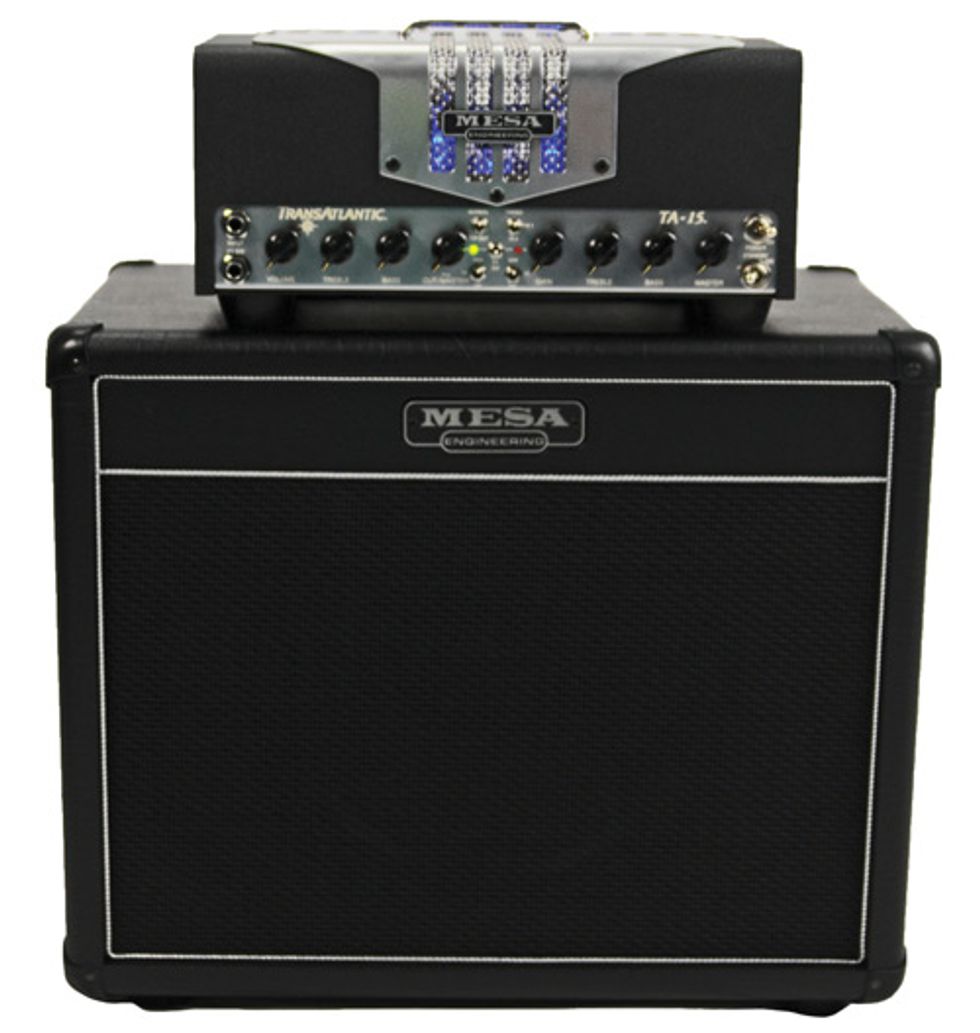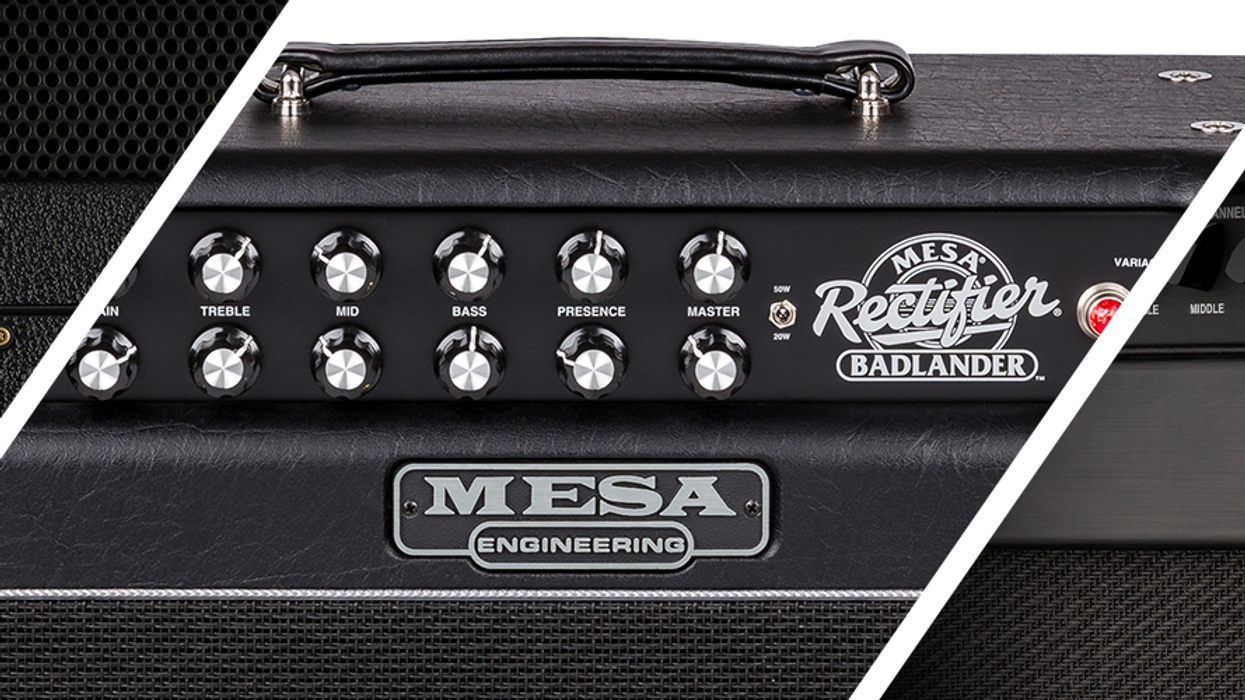Only Mesa/Boogie would release an amp
with such versatility that the manual would
be bigger than the amp itself. There’s a clear
trend toward building lunchbox-sized amp,
and Mesa makes no attempt to hide the fact
that they are late to the parade with their
TransAtlantic TA-15. But unlike many of its
competitors, Mesa brings more to the table
than just shrinkage.

Sizing It Up
| Download Example 1 HI1 Setting, 5W | |
| Download Example 2 HI2 Setting, 5 W | |
| Download Example 3 Top Boost Setting, 5W | |
| Download Example 4 Tweed Setting, 5W | |
| All samples recorded with a Gibson SG (bridge pup) and matching Mesa/Boogie 1x12" cabinet. | |
From left to right, the TA-15’s control panel features two rugged input jacks—one for your guitar and one for the single-button footswitch. Scanning Channel 1’s knobs, we have Volume, Treble, Bass, and Cut/Master, the latter of which is the only push/pull knob on the amp. When pushed in, the knob functions as an inverted Presence control (the sound gets darker as you go clockwise). Pulled out, it functions as a master volume for Channel 1, allowing you to drive this “clean side” of the amp into delicious overdrive. The Treble and Bass knobs furnish a pretty wide range of EQ attenuation, however, if you’re really into midrange you may find that it’s a bit trickier to dial it in without a dedicated control. Channel 2 dispenses with the push/pull knob and gives you a straight Master knob, in addition to Gain, Treble, and Bass knobs.
The TransAtlantic also features 4- and 8-ohm speaker outs, and the exceptionally well-written manual illustrates numerous cabinet configurations. I tested the TransAtlantic with a matching 1x12" Mesa open-back cabinet. Loaded with a 90-watt Black Shadow speaker designed for Mesa by Celestion, this nifty cab easily accommodated the TransAtlantic’s wide variety of tones. The amp head also comes with a padded gig bag. Sweet!
Meet the Toggle Switches
A bank of five mini toggles separates the knobs for Channels 1 and 2. Two switches are dedicated to Channel 1, two are dedicated to Channel 2, and one toggles between channels or allows footswitching. Each channel has a toggle to select a voicing and wattage. For Channel 1, the voicing options are Normal and Top Boost. Normal yields a good, standard clean tone with lots of headroom. Top Boost provides us with our first TransAtlantic journey to the UK, home of Vox amplifiers. Much like the fine AC30, this channel is crisp and articulate, and boasts an open low end. This setting allows your fretting technique to shine by preserving every subtle, touch-sensitive nuance as you glide and slide over the strings. Top Boost also delivers that faithfully dirty crunch that may become harsh if you’re not paying attention to your EQ settings. A simple tweak of the EQ allows those singing midrange tones through. Playing with this Top Boost voicing, I found myself losing track of time under the influence of infectious pop songs from Liverpool.
Each TransAtlantic channel also has a three-position toggle to switch between 5-, 15-, and 25-watt operation. It’s not often guitarists get the chance to clearly experience the sound power tubes make when they approach their limits. Even a 35-watt amp can pummel your eardrums to the point where your ability to discern the subtle effect of power-tube drive is diminished. One way to experience the effect is to record at high volumes and listen on studio reference monitors at low volumes. But most guitarists know there’s no substitute for the direct, speaker-to-string-to-pickup cycle to make an amplifier dance.
With the amp still in Channel 1’s Top Boost voicing, I switched to the 5-watt power setting (which doesn’t require powering down or hitting standby). With the Volume at 10 o’clock and the Master/Cut knob pulled, I was able to use the Master volume to put the power tubes to work. As the Master volume goes up, the sound changes from subtle compression to limiting, and finally to a gentle overdrive at about 2 o’clock. What I’m trying and inevitably failing to describe is my favorite TransAtlantic setting: Channel 1’s Vox-inspired, low-watt, power-tube drive. It breathes, it’s responsive, it sustains, and the touch sensitivity inspires musical expression. This multi-watt design adds tons of flexibility to an already capable amplifier. A cool feature I’d like to see is multi-watt selection and voicing selection via the footswitch.
Now that I’ve admitted to my favorite amp setting, let’s not pretend that it’s a downhill slope from there. The three-position voicing toggle on Channel 2 selects between Tweed, HI 1, and HI 2. Mesa’s intent is for these to sound like a tweed Fender, a Marshall, and a classic Mark-series Boogie, respectively. Channel 2 sends us back across the pond to Southern California, where Leo Fender’s game-changing amplifiers were unveiled in the late 1940s. With the amp in the Tweed voicing, I definitely heard that unmistakable Fender spank and thud. Tweeds and early Bassmans are known for their amazingly punchy dynamic range and the smooth, chiming overdrive they emit when you push them, and these Fender amps birthed most rock-and- roll guitar amp circuits. It’s a daunting task for a lunchbox amp to recreate this, and while the TransAtlantic’s sound is fabulous, the voicing sounded more like a Bassman than a Tweed to my ears.
I happen to own a late-’60s Bassman, and I love everything it has to offer. Bringing up the Bass on the TransAtlantic’s Tweed setting edged ever closer to that elusive Bassman punch. With the Gain at 2 o’clock, the TransAtlantic sounded like a boosted mini Bassman. Without a midrange control, I wasn’t able to exactly dial in my Bassman, but I never expected the TransAtlantic to get this close. Very impressive—and we’re only halfway through the voicings.
The TransAtlantic takes us back to the UK with the next voicing, HI 1, which pays tribute to the Marshall legacy. My instinct was to dime the gain and see how far it would go. In this setting, the attack was quick, the mids sliced, and the lows were slightly compressed, with plenty of dynamic reach. You’re not going to get all the way to modern metal tones, but you’ll definitely achieve early shred tones. While my fingers reminisced on some of Kirk Hammett’s earliest riffs, my ears soaked up the capable EL84 power section. These power amp tubes pay an excellent tribute to the EL34s typically found in Marshalls. I liked this setting dimed, with flat EQ and the output switched to 15 watts. This delivered that signature British low-end tightness and allowed my speakers to reach their full range of motion.
Our final TransAtlantic voyage takes us back to Cali for the HI 2 gain setting. There’s a lot to say about this setting, but I can sum it up with a question. Who does Boogie better than Mesa? HI 2 is a slightly modified version of Mesa’s own high-gain design pulled from their legendary Mark series. It shouldn’t surprise you that the TransAtlantic is not going to produce enough bass to crack plaster and induce tinnitus. Low-wattage amps that attempt to deliver too much bass will inevitably sacrifice important high and mid frequencies— it’s physics.
What’s important is that Mesa successfully scaled their signature sound into a unit that will give Mesa fans a chance to experience this lush distortion at room volumes. For players who want an authentic Boogie tone onstage and in the studio, you’ve now got a comparable tool for practicing and writing. I liked pairing the HI 2 and 25-watt settings, a combination that yielded extended headroom.
The Final Mojo
With the TransAtlantic, Mesa set a lofty goal—make a tiny, lightweight, sonically excellent alltube amp that’s capable of many popular voicings. And they succeeded. The TransAtlantic is as versatile as most other amp makers’ full-sized heads. While it doesn’t attempt to sail into uncharted sonic realms, it packs a ton of tones and features into a tiny footprint. And that makes it an amazing tone machine for practical guitarists of many stripes.
Buy if...
the idea of an all tube, multi-voiced, multi-watt practice amp excites you.
Skip if...
you have no volume constraints and/ or someone else schleps your gear.
Rating...
Street $899 - Mesa Engineering - mesaboogie.com |







![Rig Rundown: Russian Circles’ Mike Sullivan [2025]](https://www.premierguitar.com/media-library/youtube.jpg?id=62303631&width=1245&height=700&quality=70&coordinates=0%2C0%2C0%2C0)

















